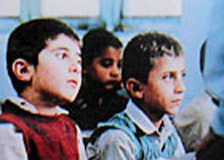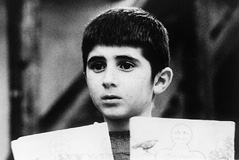|
Newest Reviews:
New Movies -
The Tunnel
V/H/S
The Tall Man
Mama Africa
Detention
Brake
Ted
Tomboy
Brownian Movement
Last Ride
[Rec]≥: Genesis
Hara-Kiri: Death of a Samurai
Indie Game: The Movie
Abraham Lincoln: Vampire Hunter
Old Movies -
Touki Bouki: The Journey of the Hyena
Drums Along the Mohawk
The Chase
The Heiress
Show
People
The Strange Affair of Uncle Harry
Pitfall
Driftwood
Miracle Mile
The Great Flamarion
Dark Habits
Archives -
Recap: 2000,
2001, 2002,
2003, 2004
, 2005, 2006,
2007 , 2008
, 2009 ,
2010 , 2011 ,
2012
All reviews alphabetically
All reviews by star rating
All reviews by release year
Masterpieces
Screening Log
Links
FAQ
E-mail me
HOME
| |
Where is the Friendís Home? (Abbas Kiarostami, 1987)
 Thereís nothing thatís really wrong with Abbas
Kiarostamiís thoughtful Where is the
Friendís Home?, except that it doesnít have as much as an effect on me
as such child-centric features as Children
of Heaven, A Summer at Grandpaís,
or even The White Balloon, which
Kiarostami himself wrote. Home tells a
simple story about Ahmed, a young schoolboy who one day accidentally takes his
friendís notebook from school, prompting a desperate attempt to return it,
lest his friend face expulsion at the hands of their hypocritical teacher. The
rudimentary plot makes the proceedings feel at times like a whimsical, less
convoluted take on the detective genre. The hero here though is a determined
young boy, instead of a disillusioned old sleuth, who wanders through the
unfamiliar side of town while meeting strangers and stringing together a series
of directions that are so vague that they almost function as clues. Thereís a
visual sense of mystery here too, as Kiarostami develops his sophisticated use
of off-screen space to exhibit the sense of discovery that the boy feels while
exploring. Frequently, the limited point of view of the protagonist is used so
the audience cannot see a characterís face or ascertain where a noise is
coming from. Unlike in his later work, in which he manages to keep major
characters off-screen, however, the sources behind the disembodied voices that
arouse the audienceís speculation are almost always revealed before the scene
ends.
Thereís nothing thatís really wrong with Abbas
Kiarostamiís thoughtful Where is the
Friendís Home?, except that it doesnít have as much as an effect on me
as such child-centric features as Children
of Heaven, A Summer at Grandpaís,
or even The White Balloon, which
Kiarostami himself wrote. Home tells a
simple story about Ahmed, a young schoolboy who one day accidentally takes his
friendís notebook from school, prompting a desperate attempt to return it,
lest his friend face expulsion at the hands of their hypocritical teacher. The
rudimentary plot makes the proceedings feel at times like a whimsical, less
convoluted take on the detective genre. The hero here though is a determined
young boy, instead of a disillusioned old sleuth, who wanders through the
unfamiliar side of town while meeting strangers and stringing together a series
of directions that are so vague that they almost function as clues. Thereís a
visual sense of mystery here too, as Kiarostami develops his sophisticated use
of off-screen space to exhibit the sense of discovery that the boy feels while
exploring. Frequently, the limited point of view of the protagonist is used so
the audience cannot see a characterís face or ascertain where a noise is
coming from. Unlike in his later work, in which he manages to keep major
characters off-screen, however, the sources behind the disembodied voices that
arouse the audienceís speculation are almost always revealed before the scene
ends.
 Though Kiarostami usually keeps the film focused on the
titular mystery, he occasionally diverges to present observations that seem
beyond his protagonist. Thereís a clear dichotomy set up between the townís
two door salesmen, for example. One is old and experienced. He can claim to have
worked on most houses in the villages and can speak eloquently about not only
his handcrafted handiwork but also the inhabitants that he helped. His
competitor is a brash and pushy young upstart, who orders steel door from out of
town and treats the people that he deals with as mere business opportunities.
Although these distinctions are simple enough for a child to grasp, Kiarostami
barely exposes his young protagonist to them, instead allowing the conclusion to
be made only by the audience. Similarly, as Kiarostami shows young Ahmed getting
lectured time and again by those who are older than him, it seems as if heís
building up to some sort of realization, but nothing really comes about from the
inclusion of the theme beyond a better feel for the environment that the boy
lives in. Though the sort of unaware focus on the goal at hand that the central
character exhibits might be realistic, it doesnít make for an especially deep
connection with the audience. Ahmed is a child though, and it might be silly to
hope for his specific story to contain more provocative themes. Itís only
because so many directors have done more with a similar set-up that Where is the Friendís Home? feels somewhat lacking.
Though Kiarostami usually keeps the film focused on the
titular mystery, he occasionally diverges to present observations that seem
beyond his protagonist. Thereís a clear dichotomy set up between the townís
two door salesmen, for example. One is old and experienced. He can claim to have
worked on most houses in the villages and can speak eloquently about not only
his handcrafted handiwork but also the inhabitants that he helped. His
competitor is a brash and pushy young upstart, who orders steel door from out of
town and treats the people that he deals with as mere business opportunities.
Although these distinctions are simple enough for a child to grasp, Kiarostami
barely exposes his young protagonist to them, instead allowing the conclusion to
be made only by the audience. Similarly, as Kiarostami shows young Ahmed getting
lectured time and again by those who are older than him, it seems as if heís
building up to some sort of realization, but nothing really comes about from the
inclusion of the theme beyond a better feel for the environment that the boy
lives in. Though the sort of unaware focus on the goal at hand that the central
character exhibits might be realistic, it doesnít make for an especially deep
connection with the audience. Ahmed is a child though, and it might be silly to
hope for his specific story to contain more provocative themes. Itís only
because so many directors have done more with a similar set-up that Where is the Friendís Home? feels somewhat lacking.
* * *
01-08-02
Jeremy Heilman
|